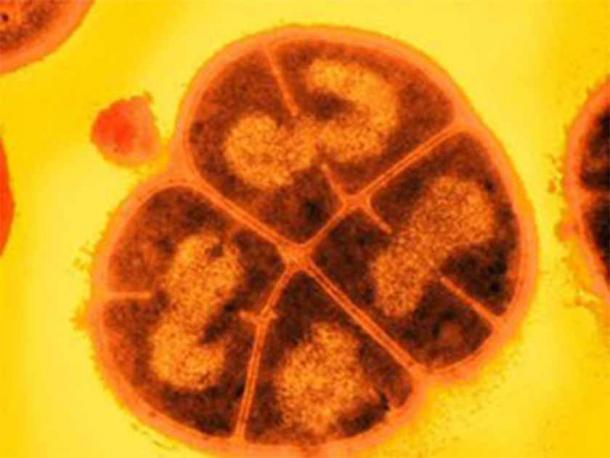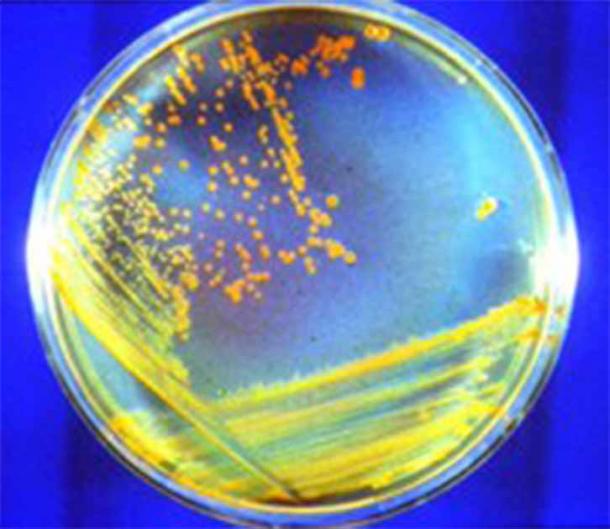Is Bacteria Hiding on Mars? Indestructible Microbe “Conan the Bacterium” Suggests There Is
Could there be living bacteria sheltered deep beneath the frozen and desiccated surface of the planet Mars? According to a team of experts, there very well could be.
Microbes might have been surviving undisturbed since the time dinosaurs walked the Earth, these scientists say, a conclusion they have drawn based on the results of a fascinating study recently published in the journal Astrobiology.
There is a type of bacteria that is so tough and hardy that it has been nicknamed “Conan the Bacterium.” Its real name is Deinococcus radiodurans, and this impenetrable microbe is resistant to extreme cold and heat, acid, dehydration, vacuum conditions, and radiation. In fact, it can withstand enormous doses of radiation without dying; it is this ability that was relevant to the newly published research. The authors of this study uncovered evidence that this hardiest of all microbial lifeforms could have survived on Mars if it had evolved there instead of here, despite the fact that Mars is continuously bombarded with toxic and deadly cosmic radiation.
Biologists who’ve studied the question believe microbes that evolved on Mars billions of years ago would bear a striking resemblance to those found on Earth today. So the discovery that Conan the Bacterium could have survived Mars-like conditions suggests that bacteria native to Mars might have developed the capacity to do the same.
- Long Frozen Organisms in the Arctic Awakened, Hinting at Life on Other Planets
- Most Convincing Evidence Yet that Mars Supported Life

D. radiodurans (affectionately known as "Conan the Bacterium") is particularly well-suited to surviving Mars' harsh environment. (Michael Daly/USU)
Meet the Mighty Conan the Bacterium: Capable of Life on Mars
If life did evolve on Mars, it would have happened more than two billion years ago, when the planet had an atmosphere, milder temperatures, and liquid water flowing across the landscape.
To survive to the present day, Martian bacteria would have had to adapt to a totally frozen planet, where temperatures average -80 degrees Fahrenheit (-63 degrees Celsius) in the mid-latitudes. Even more destructive are the deadly ultraviolet light, gamma rays, and solar-generated, high-energy protons that inundate the Martian surface constantly.
Any flora or fauna that existed on the Martian surface in the far distant past would be long extinct. However, microbial life forms are extraordinary resilient and flexible. On Earth, there are bacteria that can survive some of the harshest conditions imaginable, and if microbes evolved on Mars, they might have shared that characteristic. But could they have survived Mars’ descent into its current radioactive state? This is the question the scientists involved in the new study wanted to address.
- Promising Signs For Perseverance Rover’s Quest for Martian Life
- Water on Mars Provides Hope for Human Habitation

A sample of D. radiodurans, the bacteria that could possibly live on Mars, growing on a nutrient agar plate. The red color is due to carotenoid pigment. (Michael Daly / USU)
Led by Michael Daly, a professor of pathology at Uniformed Services University (USU) of the Health Sciences in Maryland, the team of biological scientists selected several of the world’s toughest and most adaptable microbes and fungi to be subjected to conditions mimicking those that such life forms would encounter if they were transported to Mars. These “extremophiles” are able to live in Earth environments that are completely inhospitable to all other organisms, surviving exposure to extreme heat or cold, toxic chemicals and gases, and other substances or conditions known to destroy living cells.
In carefully controlled laboratory conditions, all of these organisms were blasted with continuous heavy doses of ultraviolet light, gamma rays, and high-energy protons, to see how they could handle such exposure.
After this phase of the experiment was finished, the scientists took samples from the organisms to test for the presence of manganese antioxidants. This is a biochemical that forms in microbes after they’ve been exposed to radiation. Manganese antioxidant formation is a cellular defense mechanism, and the more of these protective molecules a microbe can synthesize, the more resistant it will be to the deleterious effects of intense radiation.
Despite their durability and resiliency, most of the extremophiles used in the experiment did not produce nearly enough manganese antioxidants to survive a Martian-style radioactive onslaught. However, there was one that did: Conan the Bacterium ( Deinococcus radiodurans to scientists).
This durable molecule was able to absorb 28,000 times the amount of radiation that would kill a human, and that protective capacity would be enough to make it viable on Mars, even as it is today.
To add further realism to the experiment, the bacteria was frozen and dried out, putting it in the suspended state it would have to enter if it were to stay alive on Mars.
Remarkably, the experiments on D. radiodurans showed that this indestructible microbe could have survived on Mars for as long as 280 million years, if it burrowed far enough underneath the surface—33 feet (10 meters) under the surface, to be precise—to limit its radiation exposure to a manageable dosage. If buried just four inches (10 centimeters) beneath the surface it could still survive for 1.5 million years, despite being regularly hit with massive amounts of cosmic radiation.
Even at a depth of 33 feet (10 meters), the radiation that hits Mars would penetrate far enough into the ground with enough intensity to kill other types of bacteria. But it seems D. radiodurans could withstand it in a state of suspended animation, and thus have the possibility of being reanimated if conditions were right.
Obviously, the scientists are not proposing that Conan the Bacterium is somehow living on Mars. This is strictly an earth-bound organism. But if life ever did evolve on Mars, the experts believe the simplest microbial life forms would almost certainly share most of the characteristics displayed by microbial life forms on Earth. This would include the capacity to survive in exceptionally harsh conditions, assuming evolutionary pressures required it—as they would on Mars.
Will Future Missions to Mars Finally Find Proof of Life?
While it seems that Martian bacteria could have survived for a long time under the planet’s surface, there is some question as to whether they would have endured until the present day.
The last liquid water to exist on Mars dried up more than two billion years ago, meaning any bacteria that evolved there would have had to retreat underground that long ago. With no water to sustain them, they would have remained in a dried or desiccated state, and after 280 million years or so (based on the Deinococcus radiodurans example), they would have all presumably died.
But Michael Daly claims this wouldn’t necessarily push all ancient bacteria into extinction.
“Although Deinococcus radiodurans buried in the Martian subsurface could not survive dormant for the estimated 2 to 2.5 billion years since flowing water disappeared on Mars, such Martian environments are regularly altered and melted by meteorite impacts,” Michael Daly said in a Northwestern University press release (Northwestern personnel participated in the new study). “We suggest that periodic melting could allow intermittent repopulation and dispersal.”
If this theory is correct, impact craters less than 280 million years old would be most likely to have living bacteria buried in the ground underneath them. In older craters, too much time would have passed since the melting event for any bacteria spawned during the event to survive, no matter how far they retreated beneath the planet’s dry and frozen surface.
Fortunately, there are plenty of craters on Mars that are on the younger side of this deadline. Now that research has shown these could be prime locations to dig in the soil looking for microbes, future missions from NASA, the European Space Agency or the China’s National Space Administration may decide to target those locations for explorer landings. If they do, it may only be a matter of time before one of these organizations announces it has found proof that life exists on Mars, and that it is still there right now.
Top image: Representative image of astronaut examining rock for bacteria on Mars. Source: dottedyeti / Adobe Stock
By Nathan Falde
References
Horne, W., et al. October 25, 2022. Effects of Desiccation and Freezing on Microbial Ionizing Radiation Survivability: Considerations for Mars Sample Return. Astrobiology. Available at: https://doi.org/10.1089/ast.2022.0065
Ancient bacteria might lurk beneath Mars’ surface. October 25, 2022. Northwestern Now. Available at: https://news.northwestern.edu/stories/2022/10/ancient-bacteria-might-lurk-beneath-mars-surface/?fj=1




















Comments
The "bags" that the rovers destroyed.. theres also plenty of uncensored evidence with the esa images .
infinitesimal waveparticles comprise what we call home the earth
manipulatable by thought ability supressed in humans since birth
Question is, would they tell us if they found human/martian bones? Almost certainly not.
Nobody gets paid to tell the truth.